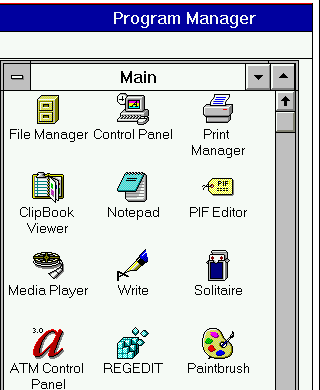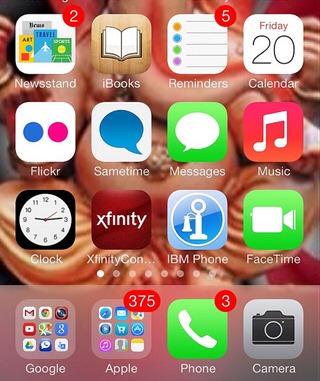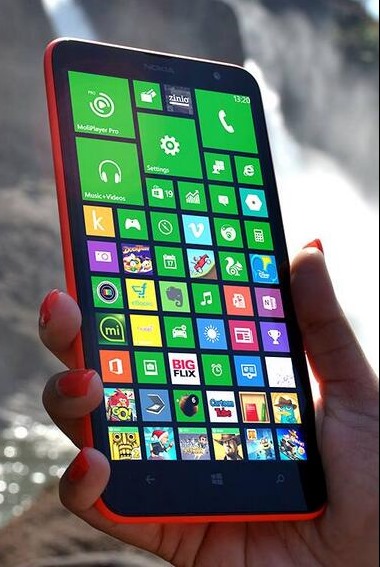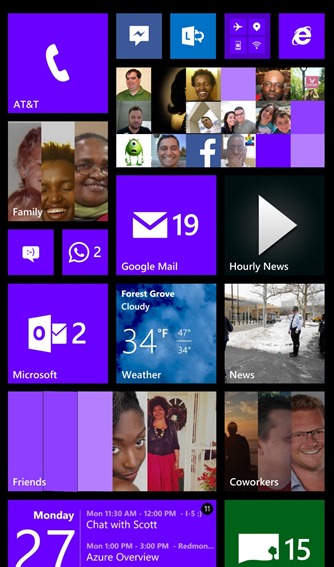NOTE: This post is just speculation and brainstorming. I'm not a UX expert by any means, although I have worked in UI testing labs, run A/B tests, yada yada yada. I dabble. Also, I work for Microsoft, but on the Web and in Open Source. I use an iPhone. Those facts don't affect my ramblings here.
I'm just a little disappointed that 30 years later (longer of course, if you consider Xerox Alto and before, but you get the idea) and we're still all looking at grids of icons. But not just icons, icons are great. It's that the icons still represent applications. Even on my iPhone or iPad I can't have an icon that represents a document. The closest I can get is to add a URL from Mobile Safari.
After Windows 3.1, Microsoft made a big deal about trying to say that Windows was a "document-centric operating system." OS/2 Warp did similarly, except object-centric, which was rather too meta for the average business user. Bear with me here, this is old news, but it was a big deal while we were living it. They kept pushing it up through Windows 98.
This document-centric approach is reflected in a number of Windows 98 features. For example, you can place new blank documents on the Desktop or in any folder window. You can access documents via the Documents menu on the Start menu. You can click a file icon and have its associated application open it, and you can define actions to be taken on a file and display those actions as options in the context menu
Today on the desktop we take all this for granted. Ubuntu, OS X, Windows all know (for the most part) how a document was created and let us open documents in associated programs. iOS is starting to get similar document-centric abilities, although it appears Open In is limited to 10 apps.
In Windows Phone and Windows 8+ I can pin People to the Start Screen. It's a killer feature that no one talks about. In fact, Nokia recently tweeted a screenshot of a 1080p Windows Phone (I've been testing the this last month myself) and I think they made a mistake here. Rather than pinning People, Faces, Groups, Friends, Family, Co-Workers, etc, they shrunk down a bunch of ordinarily good looking icons to their most unflattering to see how many they could fit on the screen.
(Plus they have 19 Updates pending, which I just find annoying.)
Here's mine next to theirs, just to contrast. Now, far be it from me to tell someone how to personalize their phone, I'm just trying to show that it doesn't have to be cartoonish.
What I'm really interested inis why do we, as humans, find App Centric interfaces more intuitive than People Centric ones?
The "story" around People Centric is that you don't think "go to twitter and tweet my friend" or "go to Skype and call my friend," instead you click a picture of your friend and then contact them in any possible way using any enlisted app from there.
For example, if I search my Windows machine for "Scott Guthrie" I get this (Scott is lousy about keeping his pictures up to date.)
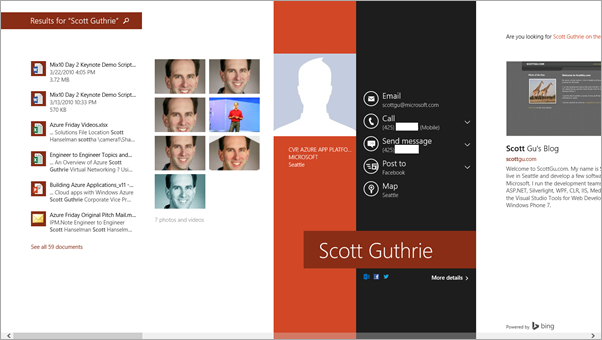
You can see from here I can Email, Call, Facebook, Skype (if he had Skype), or get a map to his house. All his actual accounts, Twitter, Facebook, etc are linked into one Scott Guthrie Person.
_52897847-267d-49c9-8256-e3c5df8f64fa.png)
It works great on the phone, where I'm more likely to do more than just email. Note at the bottom there's a chain with a number showing that my wife has 6 accounts (Google, Hotmail, Facebook, Skype, etc) that are all linked into one Contact.
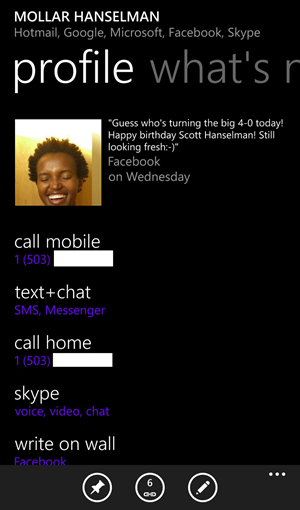
Folks that use Windows Phone mostly know about these features, and the hardcore users I know pin people to Start. On the desktop, though, I never see this. I wonder why. I am surprised that in a people focused world of social networks that elevating our friends, family and loved ones to be at least peers with notepad.exe would have happened by now.
What do you think, Dear Reader? Have you given this some thought in your interfaces?
Sponsor: Thanks to Red Gate for sponsoring Blog Feed this week! Want Easy release management? Deploy your SQL Server databases in a single, repeatable process with Red Gate's Deployment Manager. There's a free Starter edition, so get started now!
© 2014 Scott Hanselman. All rights reserved.
